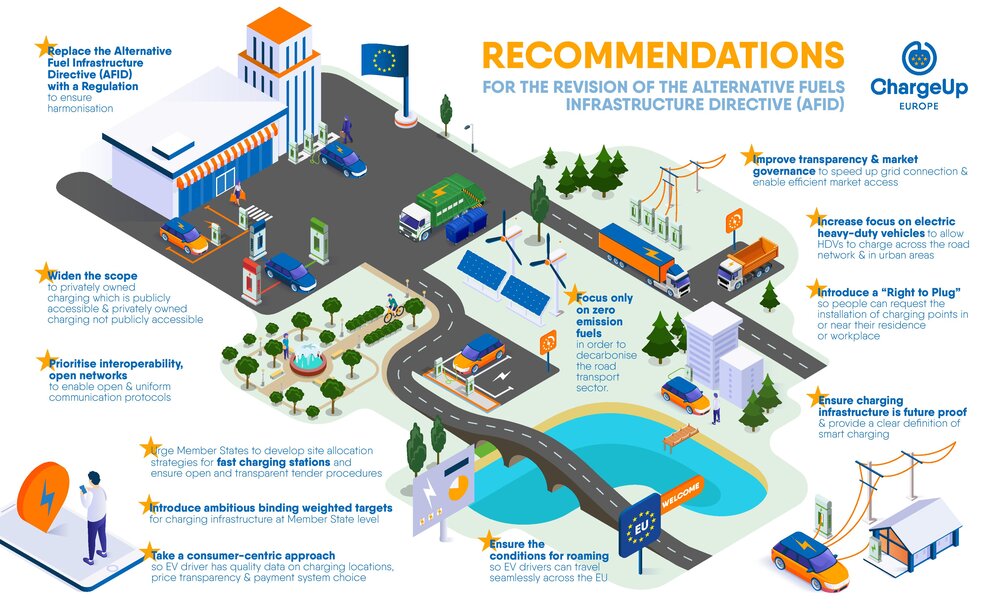Making waves with EV infrastructure reform
25 November 2020

25 November 2020
A new clean-energy strategy aimed at upgrading buildings was recently published by the European Commission. As the automotive industry gears up for a new era of electromobility, the renovation wave has the potential to transform the legislation around electrically-chargeable vehicle (EV) infrastructure. Autovista Group Daily Brief journalist Tom Geggus spoke with ChargePoint to find out more.
′We were extremely pleased with the announcement of the renovation wave for a very simple reason, because it touches upon private buildings,’ said Christelle Verstraeten, ChargePoint’s EU Policy Lead. At an EU wide level, everything related to publicly-accessible charging infrastructure falls under the alternative-fuels infrastructure directive (AFID), which is undergoing evaluation with a revision proposal due next year, she explained. This makes sense given that the directive was first adopted in 2014, making it somewhat dated when considering the advance of EV technology and demand.
′But if you talk about every charger that needs to be put in a private parking space, either at home or even possibly a private workspace, this is not AFID, it is the energy performance of buildings directive (EPBD), which is part of this renovation wave,’ Verstraeten said. As private locations are central to EV recharging, calls for greater development of this directive were made: ′we needed a higher ambition from the EU to deploy charging stations in that space.’
Currently, under article 8 of the EPBD, EU member states are required to ensure new buildings and those undergoing renovation have ′ducting infrastructure’ installed. More specifically, this means; ′conduits for electric cables, for every parking space to enable the installation, at a later stage, of recharging points for electric vehicles,’ when a specific set of criteria is met.
So, there was a sense of relief when the European Commission confirmed the EPBD would be swept up in the renovation wave. ′It is a good thing and it will be very complementary with the alternative-fuels infrastructure directive, because it is going to be private and public at the same time.’ Ensuring EVs are supported by a fully-functioning charging network will require pushing for advances on both the private and public front.
For EU member states, these directives like the EPBD act as baseline targets, which they can build upon and even exceed. Verstraeten explained that in France, the obligation to upgrade infrastructure was extended to existing buildings. Meanwhile, with its relatively high rate of EVs and contrastingly low number of garages, Amsterdam adopted a more tailored approach to installation. EV owners can ask for a charging station to be installed in the street if they are unable to charge at work or at home.
ChargeUp Europe
However, it appears current directives have resulted in fragmented approaches to infrastructure across Europe. ChargeUp, a new EV-charging industry alliance formed this year, wrote a letter to the European Commission stressing the need for a harmonised approach to the emerging market.
′To date, we have noted that the existing AFID directive has been poorly implemented in parts of the EU and that its legal basis has led to ineffective enforcement,’ ChargeUp’s letter reads. ′This has resulted in varying and inadequate EV-charging coverage, diverging national market approaches, different technology specifications and local technical requirements.’
The alliance pointed to fragmentation in metering requirements, mechanical-shutter specifications and concessions for charging along main traffic routes. This market confusion then becomes a barrier to investment, while lowering the potential of pan-European connectivity.

Source: ChargeUp
ChargeUp also pointed out that while the EPBD is a step in the right direction for EV charging, it is likely to have very limited outcomes due to its current exemptions. As part of the renovation wave, the group recommended revising infrastructure ambitions within the directive. ′Increased cabling and ducting requirements need to come with increased ambition for the installation of charging points for the whole building stock, which also provides parking spaces,’ ChargeUp explained.
The legislative puzzle
Verstraeten explained that upcoming reviews will have to bring together all the different legislative puzzle pieces, like the AFID and EPBD, to form a full picture of how infrastructure can operate in harmony across Europe. Directives can set clearly defined standards and expectations, allowing providers like ChargePoint to get a better understanding of the market and where it is heading.
′For us, if we have a clear target, it is actually easier to understand how the market is going to evolve and provide more security and certainty,’ Verstraeten said. This confidence will also extend to the consumer, where a greater understanding of the incoming infrastructure will provide a level of certainty and confidence, increasing the likelihood of EV adoption.
But because these directives do only act as targets, it still falls to individual member states to come up with goals to reach and agendas to implement. Verstraeten points out that, even then, there are still questions that cannot simply be answered by creating requirements at the EU level.
′It is not only about having the obligation to put a charger in your garage if you live in a multi-family building,’ she said. ′It is also about who is going to pay for that connection, and how the decision-making happens between the different owners of the buildings.’ While more granular issues like these will continue to cause ripples, it is only with a strong legislative foundation that Europe can hope to build EV infrastructure worthy of the electromobility tidal wave.
To find out how the electricity industry thinks the renovation wave will change EV charging, read Tom Geggus’ interview with the electricity industry association, Eurelectric.